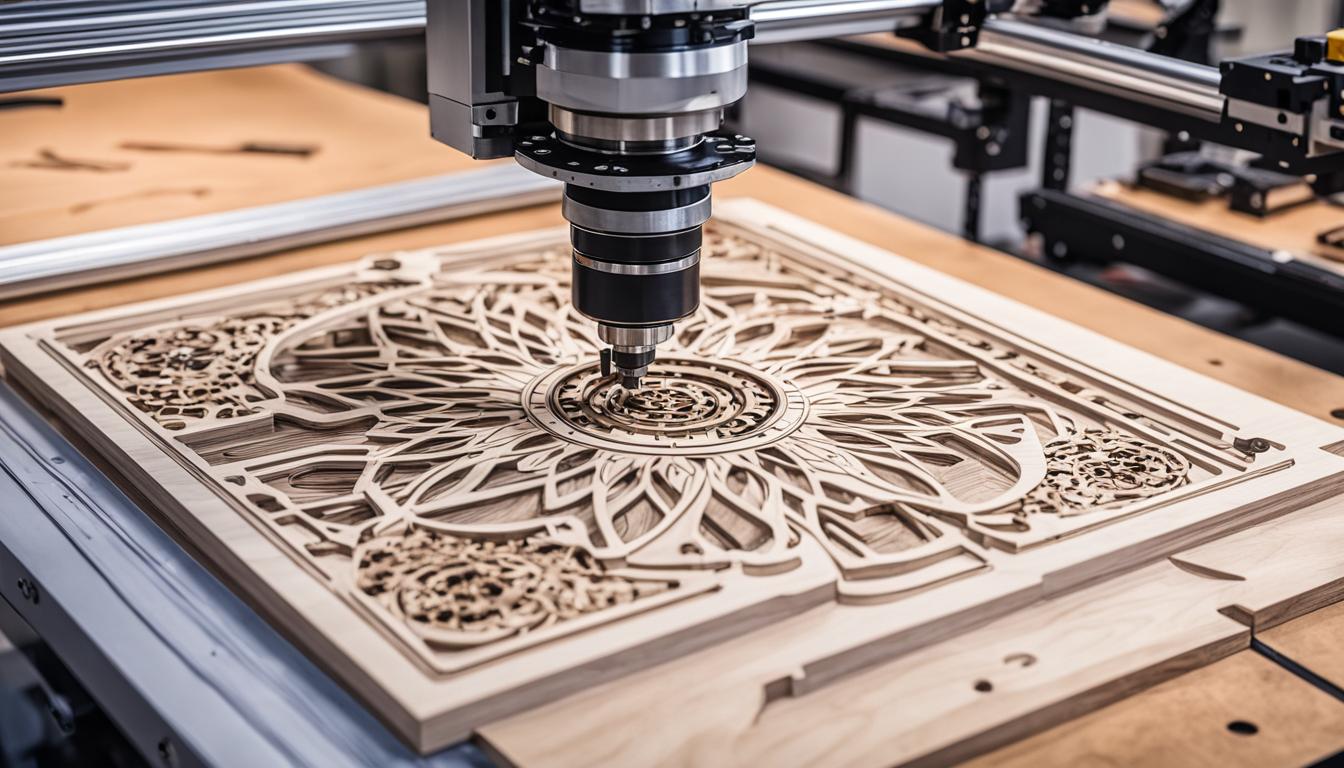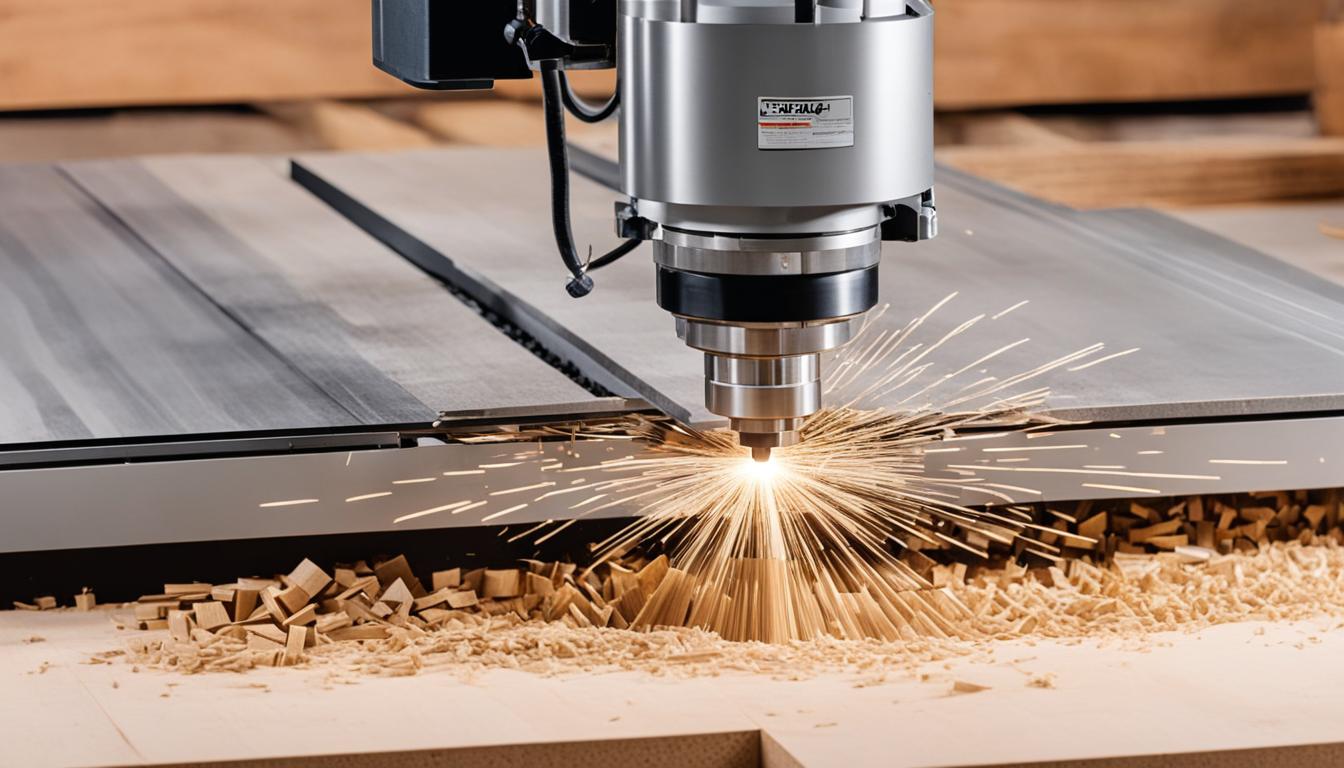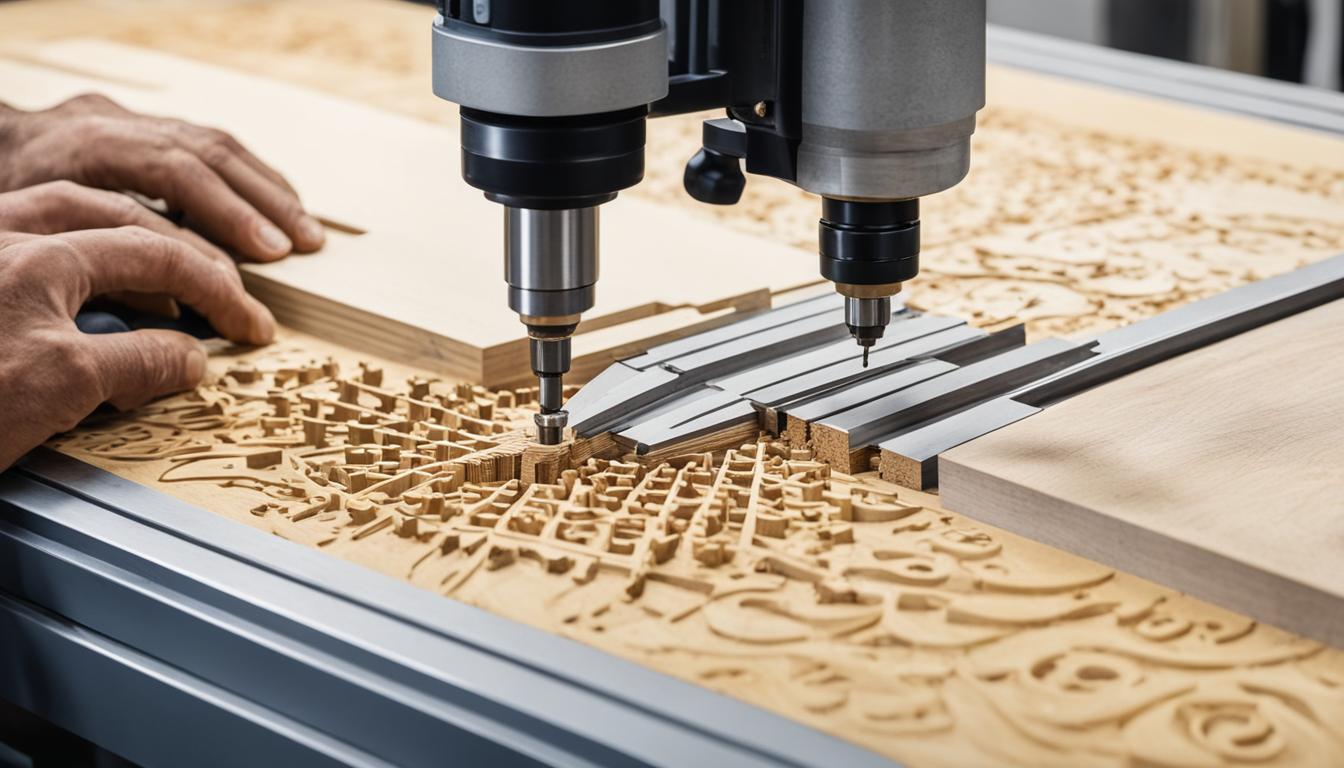A CNC router is a computer-controlled machine that performs a wide range of functions in various industries, particularly woodworking. This article will delve into the different capabilities and applications of a CNC router to provide a comprehensive understanding of its operation.
Key Takeaways
- CNC routers are computer-controlled machines used for milling, drilling, and cutting materials.
- They are commonly used in woodworking and other industries.
- CAD and CAM software is essential for operating a CNC router.
- CNC routers have specific components such as a bed, controller, motors, and spindle/router.
- They are versatile machines capable of cutting various materials and performing intricate designs.
Low Cost and Accessibility
When it comes to CNC technology, affordability and accessibility are key factors that make CNC routers an attractive option for small businesses. Compared to traditional CNC mills, CNC routers offer a cost-effective solution that doesn’t break the bank.
With their lower price tags, CNC routers provide small businesses with an opportunity to incorporate this advanced technology into their operations without making a significant financial investment. This affordability allows businesses to allocate their budget to other essential areas while still benefiting from the efficiency and precision that CNC routing offers.
Moreover, the accessibility of CNC routers makes them appealing to a wide range of industries and businesses. These machines are user-friendly and can be easily operated by individuals with minimal training. This means that even businesses with limited technical expertise can implement CNC routing to enhance their productivity and streamline their operations.
Low-cost CNC routers not only provide small businesses with a budget-friendly option but also open the door to new opportunities for growth and expansion. By investing in CNC routing technology, businesses can increase their production capacity, improve product quality, and meet customer demands more efficiently.
With the ability to handle a wide variety of materials and cutting tasks, CNC routers empower small businesses to compete on a larger scale. Whether it’s crafting intricate designs or producing custom components, these machines offer the versatility and precision required to meet the demands of today’s market.
By embracing the affordability and accessibility of low-cost CNC routers, small businesses can unlock their full potential and enhance their overall productivity. Stay tuned to explore more about the capabilities and applications of CNC routers in the upcoming sections.
CAD and CAM Software
To operate a CNC router effectively, specialized software packages are essential. These include CAD (Computer Aided Design) and CAM (Computer Aided Manufacturing) software. CAD software is designed to create precise 3D models of the desired part, allowing users to visualize and refine their designs before production. On the other hand, CAM software plays a crucial role in converting the CAD model into a language that CNC routers can understand – G-code instructions.
CAD software provides a range of powerful tools and features for creating detailed 3D models. Users can manipulate objects, define dimensions, and apply textures and materials to achieve a realistic representation of the final product. This software allows for the creation of complex shapes and geometries, making it an invaluable tool for designers and engineers in various industries.
CAM software, on the other hand, takes the CAD model and optimizes it for the CNC router. It generates the necessary toolpaths and G-code instructions that instruct the machine on how to move and cut. CAM software takes into account factors such as tool selection, cutting speeds, and feed rates to produce the most efficient and accurate results.
The Importance of CAD and CAM Integration
The seamless integration of CAD and CAM software is crucial for streamlining the CNC routing process. The ability to transfer a 3D model directly from CAD to CAM ensures accuracy while minimizing errors and rework. This integration also allows for quick revisions and modifications to the design, saving both time and effort.
Moreover, CAD and CAM software packages often come with additional features, such as simulation tools, that enable users to visualize the entire machining process before execution. This allows for the identification of potential issues or collisions and the optimization of toolpaths for increased efficiency.
By utilizing CAD and CAM software effectively, CNC router operators can achieve precise, intricate, and high-quality results. These software tools empower users to unleash their creativity and bring complex designs to life with ease and precision.

Components of a CNC Router
A CNC router machine consists of several main components that work together to achieve precise cutting and shaping of materials. These components include the bed, controller, motors, and spindle/router.
1. CNC Router Bed
The bed is the foundation of a CNC router where the raw stock or material is mounted. It provides stability and support during the cutting process. CNC router beds may have holes or attachment points for clamping hardware to secure the material in place.
2. CNC Router Controller
The controller is the brain of the CNC router machine. It drives the motion of the stepper motors and controls the speed and direction of the spindle/router. The controller interprets the instructions from the user’s input and translates them into precise movements of the machine.
3. CNC Router Motors
CNC router machines use stepper motors to drive the movement of the machine in the x, y, and z axes. These motors provide the necessary power and control to guide the cutting tool accurately along the programmed path. The motors work in tandem with the controller to ensure precise and coordinated movements.
4. CNC Router Spindle/Router
The spindle or router is the cutting tool used in a CNC router machine. It rotates at high speeds and comes in various sizes and power ratings depending on the cutting requirements. The spindle/router holds and drives different types of cutters, such as end mills or router bits, to perform precision cutting and shaping of the materials.
| CNC Router Component | Description |
|---|---|
| CNC Router Bed | The foundation where the material is mounted and secured during the cutting process. |
| CNC Router Controller | The brain of the CNC router machine that drives the motion of the motors and controls the speed and direction of the spindle/router. |
| CNC Router Motors | Stepper motors that provide the power and control to guide the machine’s movement in the x, y, and z axes. |
| CNC Router Spindle/Router | The cutting tool that rotates at high speeds and holds various types of cutters for precision cutting and shaping. |
Cutting Materials on a CNC Router
A CNC router is a versatile machine that offers precise cutting capabilities for a variety of materials. While it is primarily used for cutting non-metallic materials like MDF, plywood, acrylic, polyurethane foam, and polyethylene sheet, it also has the ability to cut softer metals such as brass, aluminum, and in some cases, steel.
However, it’s important to note that cutting harder metals like steel on a CNC router can be challenging and error-prone due to the geometry and construction of the machine. Therefore, it is not commonly used for cutting such materials. Instead, CNC routing is commonly used for engraving lettering onto harder materials like granite.
The table below provides an overview of the materials that can be cut on a CNC router:
| Materials | Cutting Capabilities |
|---|---|
| MDF |
|
| Plywood |
|
| Acrylic |
|
| Polyurethane Foam |
|
| Polyethylene Sheet |
|
| Brass |
|
| Aluminum |
|
| Steel |
|
As demonstrated by the table, CNC routers offer a wide range of cutting capabilities for various materials. With the ability to achieve precise cuts and produce smooth surface finishes, these machines are invaluable tools in industries such as woodworking, signage, prototyping, and more.

Industries That Use CNC Routers
CNC routers play a crucial role in various industries, contributing to their productivity and efficiency. Let’s explore some of the industries that extensively utilize CNC routers for their manufacturing processes:
Furniture Manufacturing
In the furniture manufacturing industry, CNC routers are widely employed to produce high-quality components from materials like wood and plastic. These machines enable precise cutting, shaping, and carving, allowing manufacturers to create intricate designs and achieve consistent results. CNC routers significantly streamline the production process, reducing both labor and time costs.
Molding
CNC routers are essential in the molding industry, particularly for creating wooden patterns used in metal casting. These machines can accurately carve intricate details on the wooden patterns, ensuring precision and consistency in the final castings. CNC routers offer versatility and adaptability, making them ideal for creating customized molds according to specific design requirements.
Packaging
The packaging industry relies on CNC routers to cut foam materials for custom housings. CNC routers can accurately cut foam into various shapes and sizes, providing reliable protection for delicate and valuable products during transit. By using CNC routers, packaging manufacturers can create customized packaging solutions that fit the dimensions and contours of the products, enhancing their overall packaging efficiency.
Advertising
In the advertising industry, CNC routers are widely used for engraving custom lettering on signs and other promotional materials. These routers can precisely carve intricate designs and produce high-quality finishes on a wide range of materials, including wood, plastic, and metal. CNC routers offer advertising companies the flexibility to create visually stunning and attention-grabbing signage and promotional items, enhancing brand visibility and recognition.
As demonstrated, CNC routers have found applications in various industries, helping businesses achieve higher productivity and maintain a competitive edge. Their versatility, precision, and efficiency make them indispensable assets in the modern manufacturing landscape.
CNC Routers in Carpentry Shops
CNC routers have revolutionized the way carpentry shops operate by providing precision, efficiency, and versatility in woodworking operations. These computer-controlled machines have become an essential tool for manufacturing a wide range of components, from simple cupboard doors to complex 3-dimensional artworks.
The applications of CNC routers in carpentry shops are vast. They can be used for cutting, shaping, and engraving wood with incredible precision, allowing carpenters to achieve intricate designs and high-quality finishes. CNC routers also offer great efficiency by automating repetitive tasks, saving time and effort for carpenters.
One of the significant advantages of using a CNC router in carpentry is the ability to produce consistent and accurate results. The computer-controlled operation ensures that each piece is cut to precise specifications, eliminating human error and reducing material waste.
Moreover, CNC routers provide versatility in design and customization. Carpenters can create intricate patterns, engravings, and complex shapes with ease, expanding the creative possibilities for their projects. CNC routers also enable the production of complex joinery and seamless connections, resulting in sturdy and visually appealing furniture and structures.
Whether it’s crafting custom furniture, architectural millwork, or decorative elements, using a CNC router in a carpentry shop offers numerous benefits. The precision, speed, and efficiency of these machines enhance productivity and the overall quality of woodworking projects.
Benefits of CNC Routers in Carpentry:
- Precision and accuracy in cutting and shaping wood
- Efficient automation of repetitive tasks
- Consistent results and reduced material waste
- Versatility in design and customization
- Creation of intricate patterns, engravings, and complex shapes
- Production of complex joinery and seamless connections
To better understand the capabilities and advantages of CNC routers in carpentry, let’s take a look at a comparison table showcasing their applications in various woodworking operations:
| Woodworking Operation | Application of CNC Routers |
|---|---|
| Cutting | Precision cutting of wood into custom shapes and sizes |
| Shaping | Efficient shaping of wood for curved or intricate designs |
| Engraving | CNC routers can engrave detailed designs and lettering on wood surfaces |
| Joinery | Creation of complex joints and connections for seamless woodwork |
| Repetitive Tasks | Automation of repetitive tasks like drilling, routing, and grooving |
Choosing the Right CNC Router
When it comes to selecting the right CNC router, it’s crucial to consider the specific requirements of your work and the skill level of the operator. Whether you’re a beginner in need of a CNC router for small-scale cutting or an industrial operation looking for a machine that can handle large-scale components, there are options available to suit your needs.
For beginners and those working with wood and foam on a smaller scale, the Shapeoko CNC router is a popular choice. It offers ease of use, affordability, and versatility, making it an excellent option for beginners who want to explore the world of CNC routing.
On the other hand, if you’re looking for a CNC router that can handle industrial-scale components and offers automation features, the ELECNC 2130 is worth considering. With its robust construction and advanced capabilities, this machine can efficiently handle large-scale production requirements in various industries.
| Best CNC Router | CNC Router Selection | CNC Router for Beginners | CNC Router for Industrial-Scale Components |
|---|---|---|---|
| Shapeoko | ELECNC 2130 | Shapeoko | ELECNC 2130 |
Before making a decision, it’s essential to evaluate the specific business case and requirements. Consider factors such as the type of materials you’ll be working with, the desired level of automation, and the scalability of the machine for future growth. By carefully considering these factors, you can ensure that you choose the right CNC router that aligns with your needs and helps you achieve optimal results.
Investing in the right CNC router can significantly enhance your productivity, efficiency, and overall business success. So, take the time to research and explore the available options to make an informed decision.
Difference Between a CNC Router and a Spindle
In the world of CNC cutting machines, there are two main options to choose from: router-based machines and spindle-based machines. Understanding the differences between these two technologies can help users make an informed decision based on their specific cutting requirements and budget.
Router-based CNC machines, as the name suggests, utilize routers as their main cutting tool. Routers are commonly used for cutting softer materials such as wood, plastics, and foams. They are known for their affordability, making them a popular choice for hobbyists, small-scale operations, and businesses with limited budgets.
On the other hand, spindle-based CNC machines employ spindles as their primary cutting tool. Spindles are preferred for cutting harder materials like metals, including aluminum and steel. They offer higher precision and accuracy, making them suitable for applications that require intricate designs or fine details.
When deciding between a router and a spindle, it’s essential to consider the specific cutting requirements. If the primary focus is on cutting softer materials and cost-effectiveness is a priority, a router-based CNC machine may be the best choice. On the other hand, if the cutting needs involve harder materials or intricate designs, a spindle-based CNC machine would be more suitable.
Ultimately, the decision between a CNC router and a spindle depends on the user’s specific needs, budget constraints, and desired level of precision. By understanding the differences between these two options, users can make an informed decision and select the CNC cutting machine that best meets their requirements.
Benefits of CNC Routing
CNC routing offers numerous advantages that make it a preferred cutting method for various industries. Let’s explore the key benefits of CNC routing:
1. Cost-Efficiency
CNC routing is cost-efficient compared to other cutting methods. It minimizes material wastage and reduces manual labor, ultimately saving both time and money. By automating the cutting process, CNC routers optimize productivity and enhance the overall cost-effectiveness of production.
2. Large Bed Size
CNC routers feature a large working area, allowing for the processing of full sheets of material. This large bed size enables efficient batch processing and streamlines the production of multiple parts simultaneously. It enhances productivity and ensures efficient utilization of resources.
3. 2.5D and 3D Capability
With CNC routers, it is possible to achieve both 2.5D and 3D cuts, adding depth and complexity to the finished products. This capability opens up a wide range of design possibilities, making CNC routing suitable for intricate designs and complex shapes.
4. Versatile Tooling
CNC routers offer versatility in tooling choices. Different router bits can be used to achieve various finishes, shapes, and edge profiles. This flexibility allows for customization and enables the production of a diverse range of products, catering to specific design requirements.
Overall, CNC routing provides precision, speed, and scalability, making it an ideal choice for industries seeking efficiency and quality in their manufacturing processes.
SendCutSend CNC Routing Services
Looking for professional CNC routing services? Look no further than SendCutSend. As a trusted provider, SendCutSend offers expert CNC routing capabilities, ensuring efficient and precise cutting of various materials. Whether you have a small project or a large-scale production, SendCutSend has the expertise and resources to deliver high-quality results.
At SendCutSend, we understand that not everyone has the necessary knowledge or resources to operate a CNC router themselves. That’s why our CNC routing service is designed to save you time and effort. Instead of investing in expensive machinery and dealing with the learning curve, you can rely on our team of experts to handle your cutting needs.
One of the key benefits of choosing SendCutSend for your CNC routing needs is our wide range of materials. We can work with various materials, including wood, plastic, metal, and more. Our precise cutting capabilities ensure accurate results, allowing you to bring your ideas to life with precision and detail.
Don’t compromise on the quality of your CNC routing projects. Trust in the expertise and professionalism of SendCutSend. Our CNC routing service provides the convenience, accuracy, and efficiency you need to bring your projects to fruition. Contact us today to learn more about how we can help you with your CNC routing needs.
